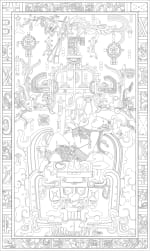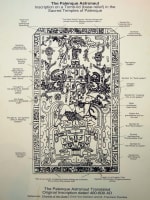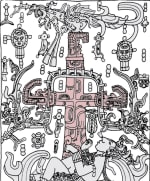The Palenque Sarcophagus Lid of King Pakal
 One of the most recognizable artifacts from the magnificent Mayan civilization is the lid of the sarcophagus of King Pakal (right). The great king ruled almost 70 years in the Mayan city of Palenque.
One of the most recognizable artifacts from the magnificent Mayan civilization is the lid of the sarcophagus of King Pakal (right). The great king ruled almost 70 years in the Mayan city of Palenque.
The tomb and its sarcophagus within were discovered in 1952 archaeologist Alberto Ruz Lhuillier in what is now known as the Temple of the Inscriptions. As one website dedicated to the sarcophagus notes:
“Pakal's sarcophagus lid is made of single stone. It is rectangular in shape, measuring between 245 and 290 millimeters (roughly 9-11.5 inches) thick in different places. It is 2.2 meters wide by 3.6 meters long (about 7 feet by 12 feet). The massive stone weighs seven tons. There are carvings on the top and sides. The massive stone would never have fit down the stairways from the top of the Temple of the Inscriptions; Pakal's tomb was sealed first and then the temple was built around it. When Ruz Lhuillier discovered the tomb, he and his men painstakingly lifted it with four jacks, raising it a little bit at a time while putting small pieces of wood in the gaps to hold it in place. The tomb remained open until late 2010 when the massive lid was painstakingly lowered once again, covering Pakal's remains, which had been returned to his tomb in 2009.” (Minster)


Sadly, the sarcophagus of Pakal isn’t primarily known due to widespread appreciation for Mayan art. Instead, it’s known because of shows like Ancient Aliens. One of the shows frequent guests, the writer Erich von Däniken, popularizes the notion that the sarcophagus lid showed an ancient astronaut in his book, Chariots of the Gods (1968).
Blogger Kathleen Rollins has reproduced one of the pages from that book featuring von Däniken’s interpretation of the lid. The interpretation of the lid as an ancient ET-Mayan flying a spacecraft has become so popular that the UFO Museum in Roswell, NM had a full-scale replica of the lid made for display.
The Palenque Sarcophagus Lid of King Pakal: The Jaded Ruler
Not surprisingly, professional archaeologists and scholars who specialize in the Mayan civilization don’t buy into the ancient astronaut view of Pakal’s sarcophagus. It turns out that the ancient alien perspective ignores just about everything the Mayan texts tell us with respect to the carved imagery on the sarcophagus lid; this is the downfall of the ancient astronaut interpretation. We ought not to sweep aside what the Mayans themselves believed in favor of what we might want to believe.
There are several trajectories that lead us to a proper, coherent understanding of the sarcophagus lid within the Mayan context (not our modern science-fiction worldview).
Let’s start with King Pakal’s body. Scherer summarizes the king’s body and its adornments:
In Classic Maya imagery, the Maize God wore a skirt and a plethora of jade adornments. Pakal’s body was similarly attired in an abundance of jade, including a mosaic funerary mask, earflares, a diadem, bracelets, a collar, a necklace, and rings on each of his fingers. The diadem consisted of forty-one jade disks and a “jester god” ornament, typical of the headbands of rulership worn by Palenque kings in the iconography. A great many of Pakal’s necklace beads and rings were delicately carved into the shapes of flowers and fruit, including cacao, pumpkin, squash, and other members of the genus Cucurbita. When restrung and worn, Pakal’s beaded bracelets strongly resemble maize cobs, with each tiny bead an individual maize kernel. Jade cylinder hair ornaments recovered near the skull match those shown in the Palenque iconography, where they bind locks of hair in a manner similar to silk curling from the top of husked maize. Pakal, dressed as the Maize God, was the embodiment of fertility and beauty. (Scherer, 247).
Karl Taube, a specialist in Maya studies, adds that, “Within the sarcophagus, Pakal was arrayed with one of the richest offerings of jade known in the Maya region” (Taube, 23). Another scholar observes, “In Classic Maya imagery, the Maize God wore a skirt and a plethora of jade adornments. Pakal’s body was similarly attired in an abundance of jade, including a mosaic funerary mask, ear flares, a diadem, bracelets, a collar, a necklace, and rings on each of his fingers.”
Both the gemstone jade had special significance to the Maya. Karl Taube elaborates:
In Classic Maya art, jade is so inextricably linked to images of Maya rulers that it is difficult to conceive of them without this precious stone. . . . In Maya studies, jade is often related to rulership and authority, wealth, water, maize, and centrality. . . jade embodies ancient Maya conceptions of wind and the breath soul. Much of the Classic Maya symbolism regarding jade has considerable time depth and can be readily traced to the earlier Olmecs. In fact, the Mayas seem to have identified jade with antiquity, both in terms of precious heirlooms passed down through generations and by the ritual use of the stone to communicate with the ancestors. . . . During the Middle Formative period of La Venta (ca. 900–500 b.c.) jade becomes far more common in the Olmec heartland and other regions of Mesoamerica. For the Olmecs of La Venta, jade was manufactured into a wide variety of items, including headdress plaques, earspools, beads, belt celts, pectorals, and figurines. The celt, however, continued to be a dominant form in Olmec jade carving. (Taube, 23)
Taube adds elsewhere, “At Late Classic Palenque, the great ruler K’inich Janaab’ Pakal was buried with jades oriented to the four quarters and world center. . . . Four large jade beads were placed at the hands and feet, framing Pakal as the world axis” (Taube, 25). In other words, the hands and feet represented “four corners,” an important religious and cosmological concept to the Maya. But that’s hardly the end of the “four-pointed” symbolism. As it turns out, the Mayan symbol is akin to our own “four corners of the earth” idea. Where do the four corners meet? At the center—the “axis mundi” (Latin for the center of the world).
The Palenque Sarcophagus Lid of King Pakal: The Sacred Tree of Mayan Cosmology
The sarcophagus lid itself explodes with the same symbolism. Celts jade objects and iconography were widely evident in the Pakal tomb—and on the sarcophagus lid. K. Rollins has produced a helpful colorization (in red) highlighting the presence of Maya glyphs on the lid that represent jade. Taube comments further on the significance, with particular attention to the sarcophagus:

. . . Aside from their economic importance, greenstone celts also had profound cosmological significance in Olmec thought by defining the four directions and world center. In ancient Mesoamerica, one of the most basic and widespread cosmological models is the four-sided world, with the intercardinal corners framing the central and pivotal axis mundi. . . . In Olmec iconography, the four-sided world is portrayed by the bar-and-dots motif, formed of a central vertical bar with four elements delineating the corners. . . . For the Mayas, the radial placement of four jades around a central image appears as early as the Late Preclassic period.” (Taube, 23,25)
In Mayan art, this four-pronged cross is actually the world tree symbol. The “world tree” symbol conveys the idea of a vertical pole that runs through the earth, uniting the heavens, the earth, and the underworld. The “tree” is like a line that unites all parts of the cosmos.
The carvings on the sarcophagus lid align with the imagery and symbolism of the way Pakal’s body was buried: “On the lid, a great tree rises behind Pakal and the scene is surrounded by celestial imagery. The tree is widely interpreted as a ‘sacred world tree,’ a great ceiba as cosmogram” (Scherer, 247). Taube agrees: “It is widely recognized that the Sarcophagus Lid from his burial chamber portrays Pakal as the maize god at the base of the world tree” (Taube, 25).
Maestri summarizes the basic elements of the Mayan Sacred Tree cosmology:
The ceiba was the most sacred tree for the ancient Maya, and according to Maya mythology, it was the symbol of the universe. The tree signified a route of communication between the three levels of earth. Its roots were said to reach down into the underworld, its trunk represented the middle world where the humans live, and its canopy of branches arched high in the sky symbolized the upper world and the thirteen levels in which the Maya heaven was divided.
Another scholar adds:
In Mesoamerican theology, the world tree grew at the locus of creation, all things flowing out from that spot into four directions. The tree thus forms part of what Mircea Eliade refers to as the "symbolism of the center." The center is, first and foremost, the point of "absolute beginning," where the latent energies of the sacred world first came into being. This source of all creation was often seen as a vertical axis, or axis mundi, which stands at the center of the cosmos and passes through each of the three major layers of existence-underworld, terrestrial plane, and sky. (Christenson, 1997, 11).
The “Alien Explorations” website, a site devoted to the imagery used in the science fiction Alien vs Predator movie, presents another helpful colorization of the four-pointed jade cross on the sarcophagus lid:
 A close up of text on a white background
A close up of text on a white background
The Palenque Sarcophagus Lid of King Pakal: Rebirth and Maintenance of Cosmic Order
One of the fundamental concepts needed for correct decipherment of the sarcophagus lid’s portrayal of Pakal and the world tree is the Mayan view of death and the afterlife. The dead king is “planted” in his tomb. From his body the world tree would “sprout,” maintaining the cosmos. Christenson elaborates:
In ancient Mesoamerica, kingship was an eternal office that, once held in life, persisted beyond
the grave. Particularly in agricultural societies like that of the Maya, survival was dependent on the rhythmic flow of one aspect of nature into its complementary opposite. Life could not exist in the absence of death. The sun must rise in its time to bestow its light and warmth on the crops. The rains must fall in their season and in sufficient amounts or the crops will not grow to maturity and the community will die. The dry, seemingly lifeless maize seed must be buried in the earth before it can sprout new plants. The king represented the hope that these forces could be controlled and ensured through ritual. He was the guarantor that the cycles of the universe would continue to be predictable and benevolent.
Royal burials were oriented as the central axis point of the universe, the place where worlds drew closest to one another. Sacred and precious things were placed in the king's tomb where they would come into contact with the life-sustaining power of the otherworld. The most precious offering was the blood and body of the divine king who, like the world tree, carried within him the seed of new life. Burial of the king's body within the bowels of a sacred pyramid symbolically returned him to the place of creation in the hope that proximity to its regenerative power would help his rebirth into godhood. The appearance of the sacred world tree growing from the underworld on the sarcophagus lid of Pakal was the symbolic expression of this concept. (Christenson, 2003, 19)
Scherer makes the same points this way:
Death for the Classic Maya was a liminal period, during which individuals underwent transformation from a living member of the community to that of an ancestor. . . . Both Classic and modern Maya notions of death and ancestors emphasize themes of rebirth, renewal, and continuation. Among the modern Maya, the life cycle of plants (especially maize) is understood as a metaphor for human life; seeds are referred to as small bones or skulls, and vice versa. According to Allen Christenson’s [work on the Popul Vuh], the Tz’utujil Maya say that when a baby is born “‘he/she sprouted’ or ‘he/she returned,’ implying that the spirit of a dead ancestor, like a newly-sprouted plant from the dead husk of a maize kernel, has returned to occupy a new body. Classic Maya kings depicted themselves as reincarnations of the Maize God, and there is abundant imagery on Maya vases showing his life, death, and rebirth. (Scherer, 245; also citing Houston, McAnany, Christenson [2007, 2010])
Christenson elsewhere draws our attention to how the lid otherwise testifies to the coherence of this perspective: “The sides of Pakal's sarcophagus are decorated with the images of ten individuals, identified by their hieroglyphic name signs as men, and a single woman, who preceded Pakal in the office of king. All are depicted in a very similar fashion, emerging from a cleft in the ground line marked with kaban (‘earth’) signs. Behind each, a fruit -bearing tree grows, indicating that they are rising from their graves in parallel fashion to the sprouting of world trees.” (Christenson, 2003, 19-20)
This interpretation is further validated by yet another detail of Pakal’s sarcophagus. As Christopher Minster observes: “On the sides and ends of the sarcophagus itself, there are eight fascinating carvings of Pakal's ancestors being reborn as trees: this shows that the spirits of departed ancestors continue to nourish their descendants. The depictions of Pakal's ancestors and former rulers of Palenque include:
- Two images of Pakal's father, K'an Mo' Hix, being reborn as a nance tree.
- Two images of Pakal's mother, Sak K'uk', being reborn as a cacao tree.
- Pakal's great-grandmother, Yohl Ik'nal, is shown twice, reborn as a zapote tree and an avocado tree.
- Janahb' Pakal I, Pakal's grandfather, reborn as a guava tree
- Kan B'ahlam I (ruler of Palenque 572-583), reborn as a zapote tree.
- Kan Joy Chitam I (ruler of Palenque ca. 529-565 A.D.), reborn as an avocado tree.
- Ahkal Mo' Nahb' I (ruler of Palenque ca. 501-524 A.D.), reborn as a guava tree.”
The Palenque Sarcophagus Lid of King Pakal: It Doesn’t Depict an Ancient Astronaut
What all this means is that the carvings on the sarcophagus lid have nothing to do with space flight. They are well known motifs throughout the scope of Mayan art. The glyphs and their imagery are agricultural yet cosmological. Their religious significance is in turn known through the writings of the Maya. It tarnishes the Mayan legacy to throw all this aside and “interpret” the lid of Pakal in a way that dismisses their beliefs and substitutes a new modern mythology of ancient aliens.
Resources
Christopher Minster, “The Sarcophagus of Pakal,” ThoughtCo website, January 15, 2018
Andrew Scherer, “The Classic Mayan Sarcophagus: Veneration and Renewal at Palenque and Tonina,” Res: Anthropology and Aesthetics 61.1 (2012): 242-261
Allen J. Christenson, “The Sacred Tree of the Ancient Maya,” Journal of Book of Mormon Studies 6.1 (1997):1-23
Allen J. Christenson, Popol Vuh: The Sacred Book of the Maya. The Great Classic of Central American Spirituality, Translated from the Original Maya Text (Norman, Oklahoma: University of Oklahoma
Press, 2007)
Allen J. Christenson, “Maize Was Their Flesh: Ritual Feasting in the Maya Highlands,” in Pre-Columbian Foodways: Interdisciplinary Approaches to Food, Culture, and Markets in Ancient Mesoamerica (ed. J. E. Stall and M. Carrasco; New York: Springer, 2010), pp. 577–600
Kathleen Rollins, “It’s Not an Alien Astronaut,” Misfits and Heroes website, March 6, 2017
Houston, Stephen D., Héctor Escobedo, Andrew K. Scherer, James L. Fitzsimmons, and Mark Child, “Classic Maya Death at Piedras Negras, Guatemala,” in Antropología de la Eternidad: La Muerte en la
Cultura Maya (ed. A. Ciudad Ruiz, M. H. Ruz Sosa, and M. J. Iglesias Ponce de León; Madrid: Sociedad Española de Estudios Mayas, 2003), pp. 113–144.
Patricia McAnany, Living with the Ancestors: Kinship and Kingship in Ancient Maya Society (Austin: University of Texas Press, 1995)
Timothy W. Knowlton and Gabrielle Vail, “Hybrid Cosmologies in Mesoamerica: A Reevaluation of the Yax Cheel Cab, a Maya World Tree,” Ethnohistory 57.4 (2010): 709-39
Jennifer P. Mathews and James F. Garber, “Models of Cosmic Order: Physical Expression of Sacred Space among the Ancient Maya,” Ancient Mesoamerica 15.1 (2004): 49-59
Karl A. Taube, “The Symbolism of Jade in Classic Maya Religion,” Ancient Mesoamerica 16.1 (2005): 23-50
Top of Form
What is your response?


